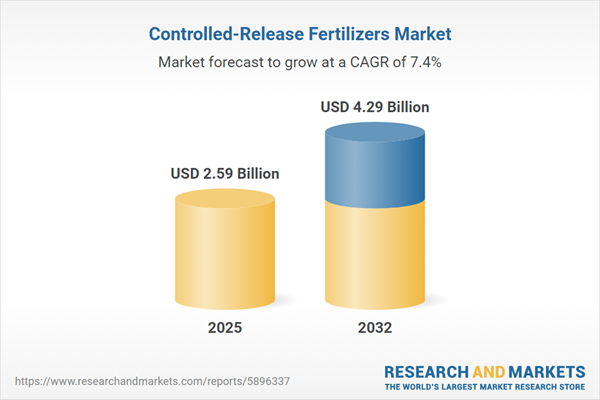Speak directly to the analyst to clarify any post sales queries you may have.
The controlled-release fertilizers market is evolving rapidly as agriculture stakeholders seek solutions that drive higher yields while enabling responsible resource use. Advances in fertilizer technology now support sector-wide goals for sustainability, precision, and operational efficiency.
Market Snapshot: Controlled-Release Fertilizer Market Trends
The controlled-release fertilizers market grew from USD 2.43 billion in 2024 to USD 2.59 billion in 2025. Forecasts suggest a 7.35% CAGR, with the market anticipated to reach USD 4.29 billion by 2032. Demand comes from producers balancing productivity goals with regulatory and environmental pressures. Investments in bio-based coating materials, digital agriculture integration, and advanced release profiles are reshaping industry standards and setting new expectations for value-added inputs.
Scope & Segmentation
This report offers a comprehensive breakdown of the controlled-release fertilizers market by product characteristics, application, region, and company leadership. In-depth coverage provides strategic clarity on key growth levers, emerging technologies, and market entry considerations.
- Coating Type: Polymer coated, sulfur coated, and urea formaldehyde-based fertilizers, each tailored for differential nutrient release and cost profiles.
- Crop Type: Segments include cereals and grains; fruits and vegetables (differentiated further into fruits and vegetables); and turf and landscape applications.
- Release Duration: Solutions are characterized by long, medium, or short nutrient release durations, supporting various cropping systems and agronomic strategies.
- Nutrient Type: Product categories consisting of nitrogen, NPK blends, phosphorus, and potassium, enabling tailored soil fertility management.
- Application: Utilization across agriculture (field crops, horticulture) and turf/ornamental areas, such as golf courses, public parks, and residential turf.
- End Use: Markets span agricultural, commercial, and residential sectors, shaped by purchasing priorities and regulatory guidance.
- Sales Channel: Offerings distributed via offline (direct sales, distributors, retailers) and online networks to optimize market reach and customer engagement.
- Geographies: Covered regions include Americas (North America, Latin America), Europe, Middle East & Africa (EMEA), and Asia-Pacific, each with unique growth drivers and regulatory regimes.
- Company Analysis: Industry coverage of leaders such as Yara International ASA, Nutrien Ltd., EuroChem Group AG, Israel Chemicals Ltd., The Mosaic Company, BASF SE, Sociedad Química y Minera de Chile S.A., Coromandel International Limited, UPL Limited, and Tessenderlo Group NV.
Key Takeaways for Senior Decision-Makers
- Controlled-release fertilizers facilitate synchronization between nutrient delivery and crop demand, reducing waste and application frequency while supporting labor efficiency.
- Adoption is increasing as end-users prioritize sustainable practices, compliance with tightening regulations, and operational risk mitigation in regions with variable climate patterns.
- Technological innovation, including smarter coatings and digital integration, enables fine-tuned nutrient management, aligning with the strategic shift to precision agriculture.
- Producers are strengthening partnerships across the supply chain, from material innovation to data-driven advisory services, driving higher value for growers and distributors alike.
- Competitive differentiation hinges on product adaptability, supply chain resilience, and alignment with localized soil and crop needs—especially in fast-growing Asia-Pacific markets.
Tariff Impact and Industry Adaptation
Upcoming United States tariff adjustments projected for 2025 are prompting industry participants to revisit procurement strategies and enhance domestic sourcing. Manufacturers are expanding local production, reinforcing distribution networks, and working closely with policymakers to ensure business continuity. Advanced product lines are prioritized to offset increased costs, while supplier–cooperative alliances focus on maintaining accessible price-points amidst regulatory shifts.
Methodology & Data Sources
This analysis draws on primary interviews with sector experts, including agronomists and supply leaders, as well as rigorous review of published research, regulatory documents, and industry filings. Quantitative models validate qualitative trends, ensuring robust cross-verification of segmentation and regional performance insights.
Why This Report Matters for Decision-Makers
- Informs product portfolio optimization and investment timing for companies seeking advantage in evolving market landscapes shaped by technology and regulation.
- Provides actionable intelligence on regional opportunities, supply chain realignment, and emerging sales channels for maximizing market coverage.
- Enables benchmarking against industry leaders’ innovation and partnership strategies, guiding operational and commercial priorities.
Conclusion
This report equips stakeholders with vital market intelligence to steer growth, address challenges, and accelerate the adoption of advanced controlled-release fertilizer solutions. Its insights enable proactive planning and sustainable business outcomes in a changing agri-inputs environment.
Additional Product Information:
- Purchase of this report includes 1 year online access with quarterly updates.
- This report can be updated on request. Please contact our Customer Experience team using the Ask a Question widget on our website.
Table of Contents
3. Executive Summary
4. Market Overview
7. Cumulative Impact of Artificial Intelligence 2025
Companies Mentioned
The companies profiled in this Controlled-Release Fertilizers market report include:- Yara International ASA
- Nutrien Ltd.
- EuroChem Group AG
- Israel Chemicals Ltd.
- The Mosaic Company
- BASF SE
- Sociedad Química y Minera de Chile S.A.
- Coromandel International Limited
- UPL Limited
- Tessenderlo Group NV
Table Information
| Report Attribute | Details |
|---|---|
| No. of Pages | 186 |
| Published | October 2025 |
| Forecast Period | 2025 - 2032 |
| Estimated Market Value ( USD | $ 2.59 Billion |
| Forecasted Market Value ( USD | $ 4.29 Billion |
| Compound Annual Growth Rate | 7.3% |
| Regions Covered | Global |
| No. of Companies Mentioned | 11 |









